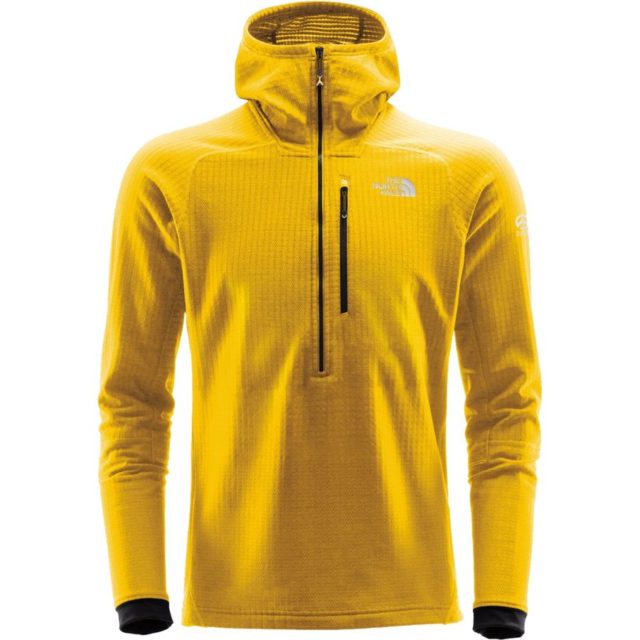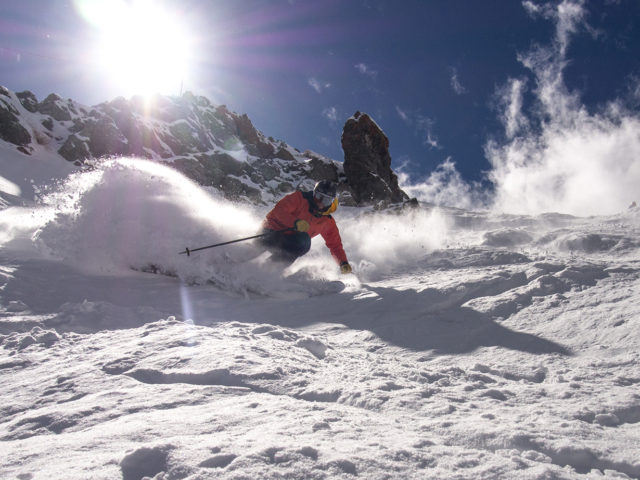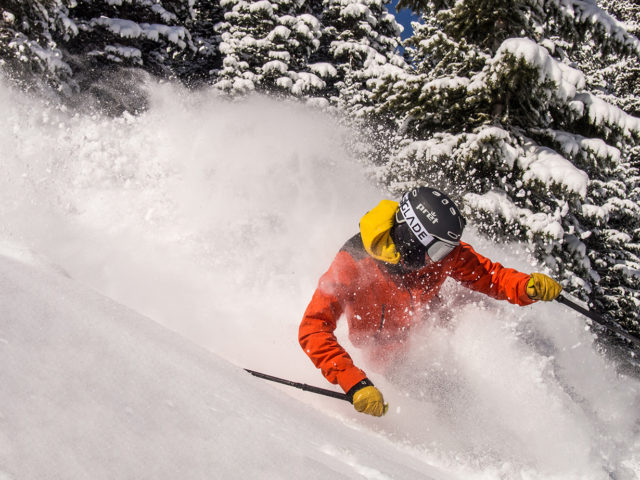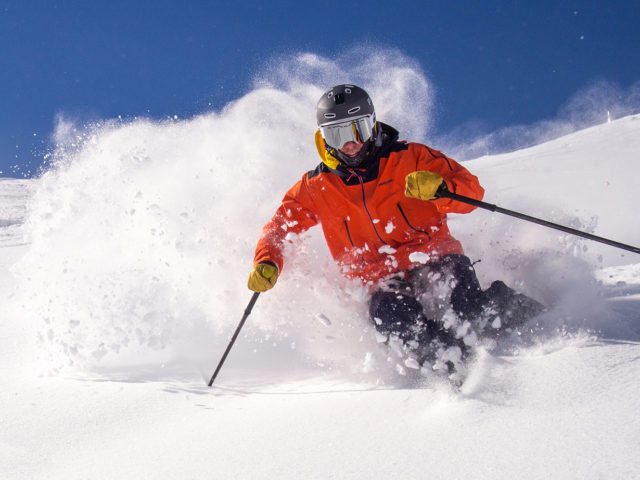
The North Face Summit L2 FuseForm Fleece ½ Zip Hoodie
Reviewer: 5’10”, 140 Ibs
Size Tested: Medium
Blister’s Measured Weight: 415 g
Fabric: 240 g/m² Polartec® Power Grid™ with Hardface® technology—93% recycled polyester, 7% elastane fleece engineered with FuseForm™ construction and DWR finish
Stated Features:
- Innovative FuseForm™ construction creates two different loft zones for durability in key areas
- Engineered grid sizes provide warmth, venting and less bulk where needed
- Exposed, VISLON® center front zip
- Exposed, reverse-coil chest pocket zip
- Minimal pocketing for optimized integration with equipment
- Under-the-helmet hood
- Stretch knit cuff with DWR (Durable water repellent) finish
- Contains at least 50% recycled content by weight
Pockets:
- One chest pocket (zippered)
MSRP: $200
Test Locations: Telluride Ski Resort, Front Range, Rocky Mountain National Park, & Summit County, CO; Wasatch Mountains, UT; Hokkaido, Japan
Days Tested: ~35
Intro
Fleece jackets have been around forever, but a lot has happened since Polartec developed the first synthetic pile fleece in the late 1970’s. From hardface fabrics that are as weather-resistant as some soft shells, to extremely light and open knits that give puffy insulations a run for their money, we now have a wide range of options when it comes to fleece mid layers.
A few years back, The North Face made my all-time favorite fleece mid layer, the FuseForm Dolomiti ¼ zip Hoodie. It was extremely breathable, surprisingly weather-resistant, and had a great fit and feature set for a variety of outdoor activities.
The North Face then discontinued the Dolomiti, and replaced it with the Summit L2 FuseForm Fleece ½ Zip Hoodie.
So how does the new L2 FuseForm Hoodie compare to its predecessor, as well as other mid layers like the Patagonia R1 Hoody, R1 TechFace Hoody, and North Face Ventrix Hoodie?
[Note: The North Face’s naming scheme can be pretty confusing, since they make several products under the “Summit L2” name (e.g., the Summit L2 FuseForm Fleece ½ Zip Hoodie, Summit L2 FuseForm Fleece Full Zip, and Summit L2 Proprius Grid Fleece Hoodie). In the case of this review, when we say “L2 FuseForm Hoodie” or “L2” we are only referring to the Summit L2 FuseForm Fleece ½ Zip Hoodie.]
Fit
The L2 FuseForm Hoodie’s fit is one of the biggest differences between it and similar mid layers like the Dolomiti and the regular Patagonia R1 Hoody.
The fit on the L2 Hoodie L2 is surprisingly generous for a technical mid layer. On my 5’10”, 140 lb frame, the L2’s sleeves come past my first knuckle, its hem goes below my hips, and I have plenty of room to layer underneath (unlike the Dolomiti and R1, which are both pretty form-fitting).
For a piece like the L2 that is specifically designed for alpine climbing, I would personally prefer a slimmer fit to cut down on bulk and weight. The L2’s fit makes the piece feel very casual, which does make it look less out of place while wearing it in town, but its fit can make the L2 difficult to integrate into a technical layering system.
Many of my outer layers aren’t long enough to cover the L2’s hem (e.g., the Rab Sharp Edge jacket and Patagonia Knifeblade jacket). This leaves the L2’s hem hanging out the bottom, free to get wet and frozen in the elements. The generous cut in the L2’s sleeves also makes it feel a bit restrictive when layered under slimmer outerwear like the pieces mentioned above.
But while the L2 doesn’t work very well when layered under slimmer alpine shells, it works much better when layered under more relaxed-fit shells (e.g., the Strafe Pyramid Jacket or Patagonia Descensionist Jacket), or as an outer layer for alpine climbing.

To put the L2 FuseForm Hoodie’s fit into perspective, the Patagonia R1 TechFace Hoody fits almost identically to the L2. But the R1 TechFace Hoody is actually more of a soft shell than a fleece (though it can still be used as a mid layer). The R1 TechFace Hoody has a helmet-compatible hood, three pockets, and a denser fabric that repels wind and precipitation significantly better than the L2. So the R1 TechFace Hoody’s larger fit makes a bit more sense since it can actually work quite well as an outer layer in many situations. The L2, on the other hand, has a minimal feature set and a less weather-resistant fabric that make sense for a mid layer, but it fits more like an outer layer. So if you want to layer the L2 under slim, technical outerwear, I’d recommend sizing down.
But not everyone needs or wants a super-slim fit in their mid layers, and if you found the form-fitting cut of fleeces like the standard R1 Hoody or Dolomiti too tight, then the L2 could be a great option.
Materials
The L2 FuseForm Hoodie is made from a Polartec Power Grid fabric with Hardface technology and uses The North Face’s proprietary FuseForm construction. That’s a lot of fancy words for one fabric.
Essentially, the L2 FuseForm Hoodie uses a version of Polartec’s classic Power Grid fleece that features a slightly denser knit on the outside. The result: little square pillows of fluffy fleece on the inside and tougher, less stretchy fabric on the outside. The regular R1 Hoody also uses Polartec Power Grid fabric, but the R1 Hoody’s face fabric is much more supple and not as dense as the L2’s “Hardface” Power Grid fabric.
The North Face’s FuseForm construction allows them to modulate the knit of the fabric in certain areas without adding a traditional seam. In the case of the L2, the FuseForm construction is used to change the size of the fleece grid to increase durability and breathability in key areas. The grid on the L2’s fabric is smaller on the front bottom panel, the upper back, and center of the hood to increase breathability in those areas. A higher-loft fleece is used everywhere else to maintain warmth.
Features
The L2 FuseForm Hoodie is pretty sparse on the features. The jacket has a ½ zip on the front and a mid-sized, zippered chest pocket that can hold a phone and a bar or two.
The L2’s cuffs are made of a black knit fabric that is stretchy, soft, and comfy against the skin.
The L2’s hood is designed to fit under a helmet, but like the rest of the jacket, the hood is cut rather large. It’s not quite large enough to fit over a helmet, but it’s big enough that it leaves some extra fabric under one — especially if you have a smaller head like me.

Unlike the R1 Hoody and Dolomiti, the hood of the L2 doesn’t double as a skull cap / neck gaiter when zipped up — the L2’s hood is looser and does not come up as high on the face as the hoods on either of those pieces.
Weight
Weighing in at 415 g for a Medium, the L2 FuseForm Hoodie is definitely not the lightest mid layer on the market. The Dolomiti, R1 Hoody, and Patagonia Nano-Air Light Hoody all provide similar amounts of warmth for less weight. But if you’re someone who tends to put on your fleece at the beginning of the day and just leave it on (i.e., not stashing it in your pack), the L2’s weight is less of an issue.
For reference, here are some of our measured weights for a few notable pieces:
272 g Arc’teryx Atom SL Hoody, size Large
274 g Norrona Lofoten Alpha Raw Zip Hoodie, size Medium
299 g Patagonia Nano-Air Light Hoody, size Medium
346 g The North Face Summit FuseForm Dolomiti ¼ Zip Hoodie, size Medium
364 g Patagonia R1 Hoody (stated weight)
410 g Patagonia Nano-Air Hoody, size Large
410 g Arc’teryx Procline Hybrid Hoody, size Large
415 g The North Face Summit L2 FuseForm Fleece ½ Zip Hoodie, size Medium
416 g Patagonia R1 TechFace Hoody, size Medium
427 g The North Face Ventrix Hoodie, size Medium
437 g Patagonia R2 TechFace Jacket, size Medium
Weather Resistance
The Polartec Power Grid fabric used on the L2 FuseForm Hoodie is more similar to that of the regular R1 Hoody than it is to the R1 TechFace Hoody and Dolomiti in terms of weather resistance. The L2’s fabric will block a small amount of wind and very light precipitation, but it certainly feels more like fleece than a soft shell (whereas the R1 TechFace Hoody is the opposite).

The Hardface tech used on the fabric of the L2 seems to help more with durability than weather resistance. The L2’s outer fabric has a distinctly harder / less supple feel than the standard R1 Hoody’s fabric, and I’ve found that the L2’s fabric is less likely to snag on rough rocks or foliage than the soft, spongy fabric of the regular R1. If I had to grovel up a coarse granite chimney in my fleece, I’d definitely take the L2 over the standard R1 Hoody.
Breathability
If there is one category where the L2 FuseForm Hoodie seems to beat both the Dolomiti and the regular R1, it’s breathability. Even though the face of the L2 is a bit harder / denser than the R1 and Dolomiti, the L2’s fabric still has a pretty open knit structure which leads to a good amount of air flow and subsequently, breathability. There isn’t a huge gap in breathability between these three pieces, but I would put the L2 FuseForm Hoodie at the top of the list.
Warmth
The L2 FuseForm Hoodie is a bit thicker than the Dolomiti so the L2 does provide a bit more warmth than the Dolomiti. The L2 isn’t quite as warm as the original R1 (though it’s pretty close), and the L2 is definitely not as warm as active insulations pieces like the Patagonia Nano-Air Light Hoody, Outdoor Research Ascendant, or The North Face Ventrix Hoodie.
If the temps are going to be near or above freezing, I find that layering the L2 with a light, long-sleeve base layer and hard shell works well for inbounds skiing. For ski touring, I can wear a light base layer and the L2 as an outer layer on the way up during most mid-winter tours here in Colorado. If it gets windy, starts to snow really hard, or if the temps dip below 20°F, then I’ll usually add a soft shell over the L2 while ski touring.
Durability
After about 35 days in the L2 FuseForm Hoodie, it looks essentially brand new, which I’d attribute to the L2’s Hardface fabric. As I noted above, the L2’s fabric does a significantly better job of brushing off rocks and branches than the regular R1 Hoody. If I run into any durability issues in the future, I’ll be sure to update this review.
Who’s It For?
I think the L2 FuseForm Hoodie makes the most sense for people who want the breathability and overall performance of more technical fleeces, but don’t want those other fleeces’ slim fits. If the more generous fit works with your frame and layering system, the L2’s excellent breathability and above-average durability make it a good option for a variety of activities.
Bottom Line
The North Face Summit L2 FuseForm Fleece ½ Zip Hoodie is a mid layer that combines the breathability and minimal feature set of technical fleeces with a more relaxed fit. Its looser fit doesn’t make it ideal for layering with slimmer shells, and its fabric isn’t as weather-resistant as some other hardface fleeces like the Patagonia R1 TechFace Hoody. But if you appreciated the performance of mid layers like the Patagonia R1 Hoody but want a more generous, relaxed fit and better durability, then the L2 FuseForm Hoodie is definitely worth a look.
